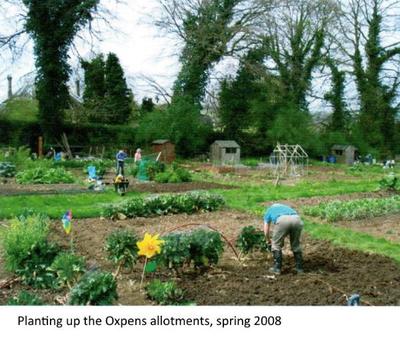
The History of Charlbury through .... our allotments
Judy Dod for Charlbury Museum
The idea poorer labourers should have access to land for growing food can be traced back to the enclosures which began in the 16th century, and the open field strips available to villagers in Saxon and Norman times. However the allotment system today has its roots in the nineteenth century, and peaked during the First and Second World Wars when food imports fell and feeding the nation became a huge problem.
By the 1870s one in three agricultural workers had a plot: they were certainly popular in Charlbury. On Easter Monday 1888 Mr Wynne of Cornbury Park invited 40 of his allotment tenants to dinner, followed by singing and dancing until 11pm. In 1889 he provided 110 allotments varying in size from 2 chains to 2 ½ acres at an average rental of 3/- per chain.
Land near the station (now the lower station car park) was set aside for railway workers. Albert Sturdy, a plate layer, grew potatoes, swedes and other root vegetables on his. He would fetch the potatoes in a wheelbarrow and wheel them up to Woodstock Road to be stored for winter buried in a pit in his garden. Every plot had a large rhubarb plant and Mr.Thornton kept pigs on his patch.
The First World War led to a huge surge in demand: by 1918 about 1.5 million plots were being cultivated. The Oxford Times reported in 1917 ‘Mr S Heaton, the County Council garden expert… is making arrangements for half a ton of good seed potatoes to be sent to Charlbury and Mr. Cowley will sell these … at cost price’. There was further expansion in 1919 when allotments were opened to all to help returning war veterans.
During World War II people were urged to Dig for Victory and more land was allocated as allotments (see map below). Potatoes were the most popular crop and clubs Onion Clubs encouraged people to grow onions which virtually disappeared from shops by 1941. Allotments declined in popularity in the late 50s and many disappeared under housing in the 1960s as Charlbury grew dramatically in size. However, a small plot of land was made available behind Evenlode Close on Nine Acres Lane and Mrs. Kilby who owned Hazeldene gave Oxpens to the town for allotments when Pest House Piece was sold for development. These are run by the Town Council while those at Fiveways are on land owned by Lee Place, originally intended for tenants of Wellington Cottages. Although on a smaller scale than in the past, allotments are thriving once again in Charlbury.
We have lots more detailed information about the history of Charlbury's allotments in the museum
Join Charlbury Garden Society for horticultural tips and information : see https://www.charlbury.info/community/30





